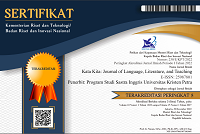The Illocutionary and Perlocutionary Acts Produced by The Main Characters of Moxie Movie
(1) Petra Christian University
(*) Corresponding Author
Abstract
Speech acts are crucial in establishing and achieving a conversation's goal. The purpose of this research is to examine speech acts in the Moxie movie. This study examines types of illocutionary acts and perlocutionary acts produced by the main characters of the Moxie movie, Vivian and Claudia. The writer used two different theories to conduct this research: the theory of speech act by Austin (1962, as cited in Cutting, 2002) and the classification of illocutionary act by Searle (1975, as cited in Cutting, 2002) and Leech (1983, as cited in Peccei, 1999). This study was done using a qualitative approach. The data that the writer used to analyze were Vivian and Claudia’s conversations in the Moxie movie. The results of the data analysis revealed that there were four types of illocutionary acts produced by Vivian: Representative, Expressive, Directive, and Rogative. Meanwhile, Claudia produced five types of illocutionary acts: Representative, Expressive, Directive, Commissive, and Rogative. Also, there were two effects of the perlocutionary acts, whether it is in accordance or not in accordance with the illocutionary act. In conclusion, this study has examined how the main characters of Moxie movie deliver their messages through speech acts.
Keywords
Full Text:
PDFReferences
Cutting, J. (2002). Pragmatics and discourse: A resource book for students (1st ed.). Routledge.
Finegan, E. (2014). Language: Its structure and use (7th ed.). Cengage Learning.
Huang, Y. (2007). Pragmatics. Oxford University Press
O’Keeffe, A., Clancy, B., & Adolphs, S. (2019). Introducing pragmatics in use (2nd ed.). Routledge.
Paltridge, B. (2012). Discourse analysis. Van Haren Publishing.
Peccei, J. S. (1999). Pragmatics (language workbooks) (1st ed.). Routledge.
Subslikescript.com (Author). (2021). Moxie [Film]. Paper Kite Productions.
DOI: https://doi.org/10.9744/katakita.10.3.564-570
Refbacks
- There are currently no refbacks.
Supported by:
Indexed in:
Tools:
Stats (installed since 17 December 2018)
View My Stats













